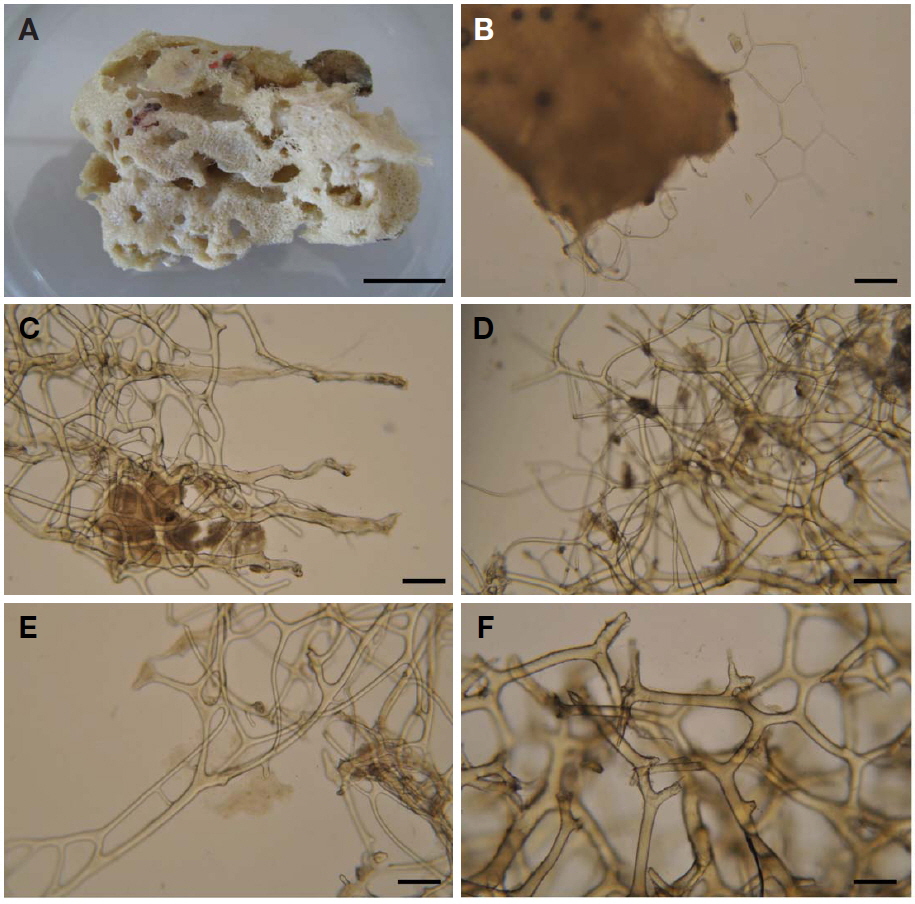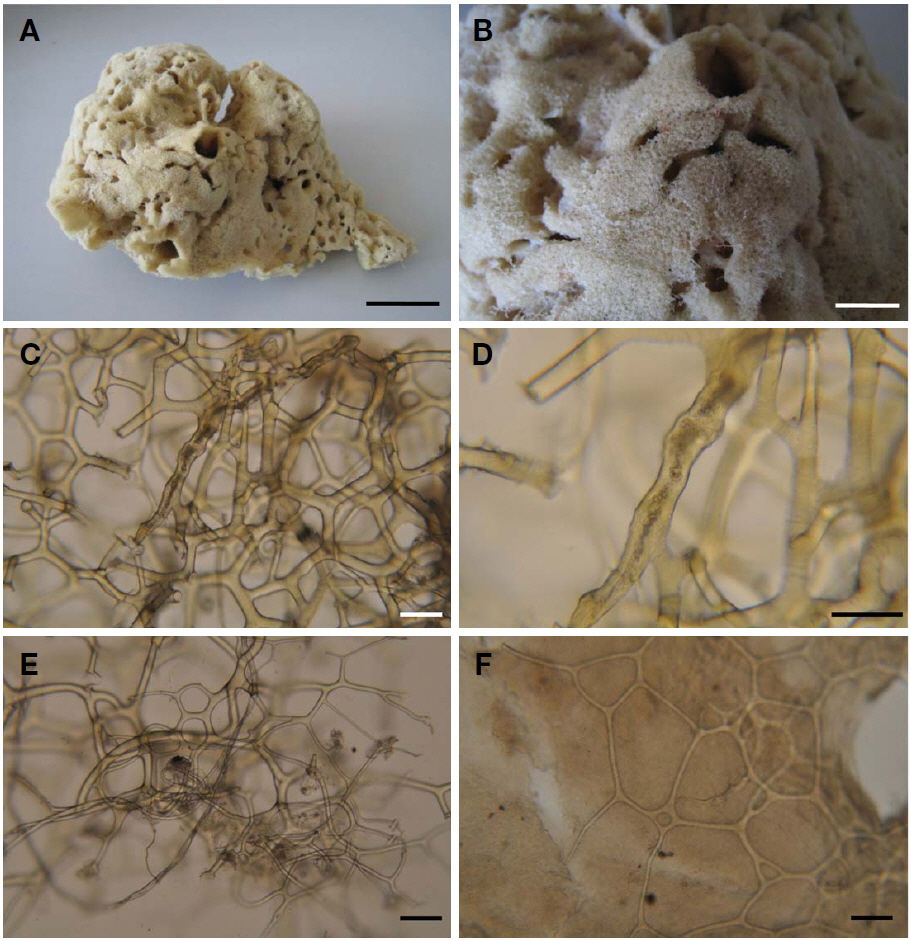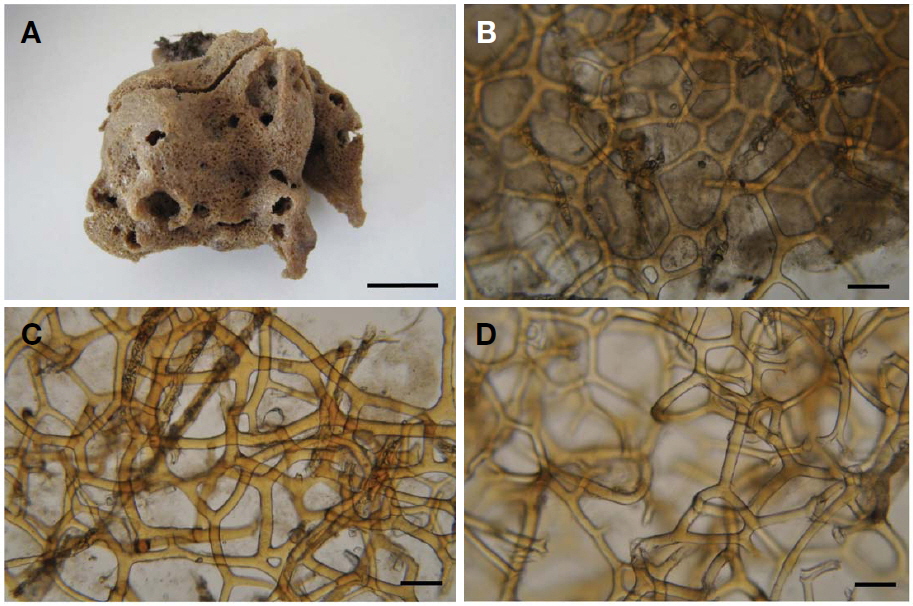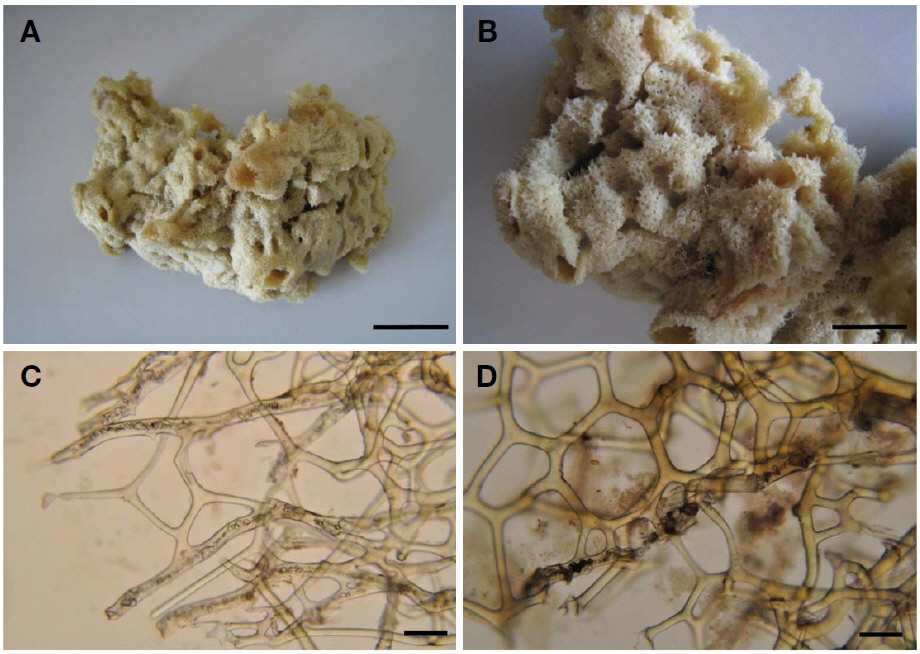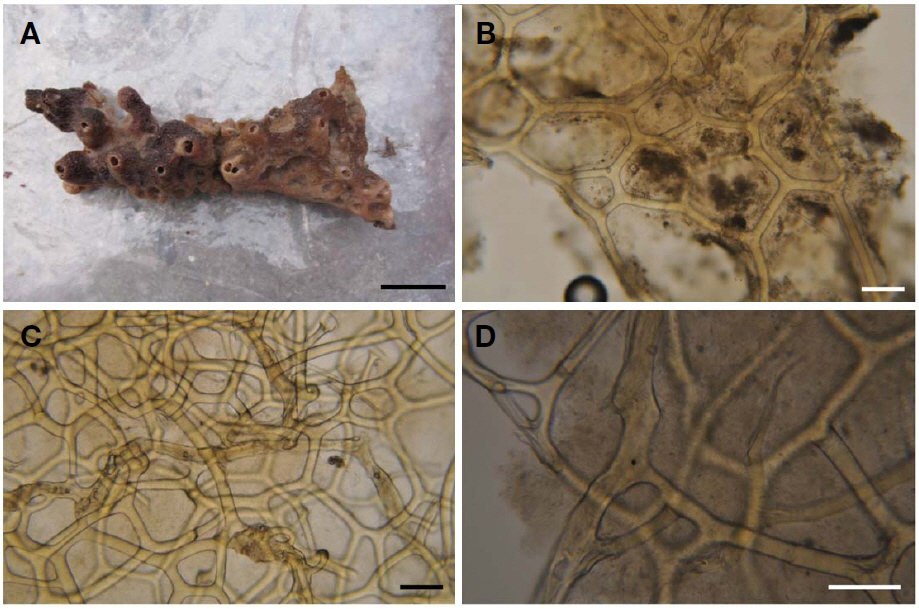



The genus
Specimens were collected from depth of 5-25 m at Jeju-do by SCUBA diving, during the period 2000-2012. All specimens were fixed in 95% or absolute ethanol. Identification was made on the basis of external features of the sponges, including growth form and skeletal structure.
This procedure followed the methods of Sim and Lee (2002). Sponges were examined under stereomicroscope (Stemi SV 6; Carl Zeiss) and light microscope (Axioscop II; Carl Zeiss). The Voucher specimens examined in this study were deposited at the National Institute of Biological Resources (NIBR), Incheon, Korea.
Phylum Porifera Grant, 1836
Class Demospongiae Sollas, 1885
Order Dictyoceratida Minchin, 1900
Family Spongiidae Gray, 1867
Genus
Material examined. Holotype (NIBRIV0000300313), Korea, Jeju-do, Jeju-si, Hankyung-myeon, Gosan-ri, Chaguido Island, 19 Oct 2001, Lee KJ, by SCUBA diving, depth 5 m, deposited in the NIBR.
Description. Massive sponge, size up to 8×6×3 cm. Surface, smooth with numerous holes and many irregular folds of thin sheets like paper. Dermal membrane with thin regular network fibres, 5-10 μm in diameter. Thin fibres separate readily from dermal membrane. Texture, soft and compressible. Color, beige in life.
Skeleton: Primary fibres, 40-60 μm in diameter, very slightly cored with small sands. Uncored secondary fibres, 15-45 μm in diameter, well developed and make complex mesh. Thin long secondary fibres, 5-10 μm in diameter, run from thick secondary fibres which appear near surface.
Etymology. This species is named after the type locality, Chaguido Island, Jeju-do, Korea.
Remarks. This new species is similar to
Material examined. Holotype (NIBRIV0000300314), Korea, Jeju-do, Seogwipo-si, Munseom, 7 Nov 2000, Lee KJ by SCUBA diving, 20 m in depth, deposited in the NIBR.
Description. Thickly incrusting, cushion shape, size up to 16×6×7 cm. One large oscule like hole, 1.5 cm in diameter, open on side of sponge body. Small multi-hole, 2-3 mm in diameter, irregularly scattered over sponge surface. Smooth surface has thin membrane with fibre network. Color, beige and partially purple in life. Texture firm and compressible because of very cavernous interior.
Skeleton: primary fibres, 40 μm in diameter, cored with small sands. Secondary fibres, 20-60 μm in diameter. Thin long secondary fibres, 10 μm in diameter, run from thick secondary fibres.
Etymology. This species is named after the type locality, Munseom, Seogwipo-si, Jeju-do, Korea.
Remarks. This new species is similar to
Material examined. Holotype (NIBRIV0000300315), Korea, Jeju-do, Chuja-myeon, Sumsangi, 11 Oct 2012, Kim HS, by SCUBA diving, depth 30 m, deposited in the NIBR.
Description. Massive, very cavernous sponge, size up to 7×4×5 cm. Surface with thin membrane, very smooth. Diverse oscules-like hole in size, 3-5 mm in diameter, open at sponge surface. Color, purple in life but gradually change to dark brown in alcohol. Texture, very soft and compressible.
Skeleton: primary fibres, 80-100 μm in diameter, densely cored with large sands. Secondary fibres, 30-50 μm in diameter, made regular mesh.
Etymology. This species is named after the type locality, Sumsangi, Chujado Island, Jeju-do, Korea.
Remarks. This new species is similar to
Material examined. Holotype (NIBRIV0000300316), Korea, Jeju-do, Jeju-si, Chuja-myeon, Jeolmyeongyeo, 2 Aug 2002, Lee KJ, by SCUBA diving, depth 25-35 m, deposited in the NIBR.
Description. Thickly encrusting, size up to 15×7×2 cm. Uneven surface with wrinkles and several elevated hole-like tubes, 1 cm diameter, 1-1.5 cm height. Texture, firm and compressible. Color, brownish violet in life.
Skeleton: primary fibres at surface 40-80-100 μm in diameter, made fascicle, clear sand core, secondary fibres 25-40 μm in diameter made regular mesh.
Etymology. This species name
Remarks. This new species is similar to
Material examined. Holotype (NIBRIV0000300317), Korea, Jeju-do, Jeju-si, Chuja-myeon, 9 Oct 2012, Kim HS, by SCUBA diving, depth 25 m, deposited in the NIBR.
Description. Thickly encrusted on the substrate, size up to 16×4×5 cm. Surface has many long tubes with oscule-like holes, 5-8 mm in diameter, coalescent at bottom. Thin membrane over surface with thick regular fibre network, and mucous. Surface color dark purple, interior pale brown and beige. Texture soft, compressible and easy to tear. Inside of sponge, cavernous. Small conules occur at surface.
Skeleton: primary fibres, 60-150 μm in diameter, very rarely cored with sands. Secondary fibres, 10-40 μm in diameters, not cored, and meshes, 45-90 μm in diameter or 234-436 μm in diameter.
Etymology. This species is named after the live color purple.
Remarks. This new species is similar to
In this study, the finding of five new
[Table 1.] Comparison of new species of genus Hyattella
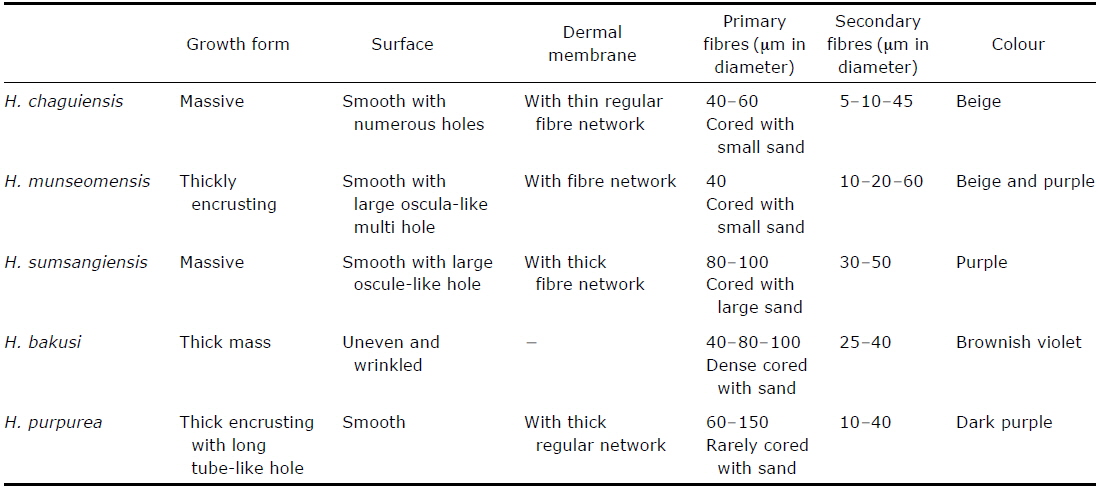
Comparison of new species of genus Hyattella

